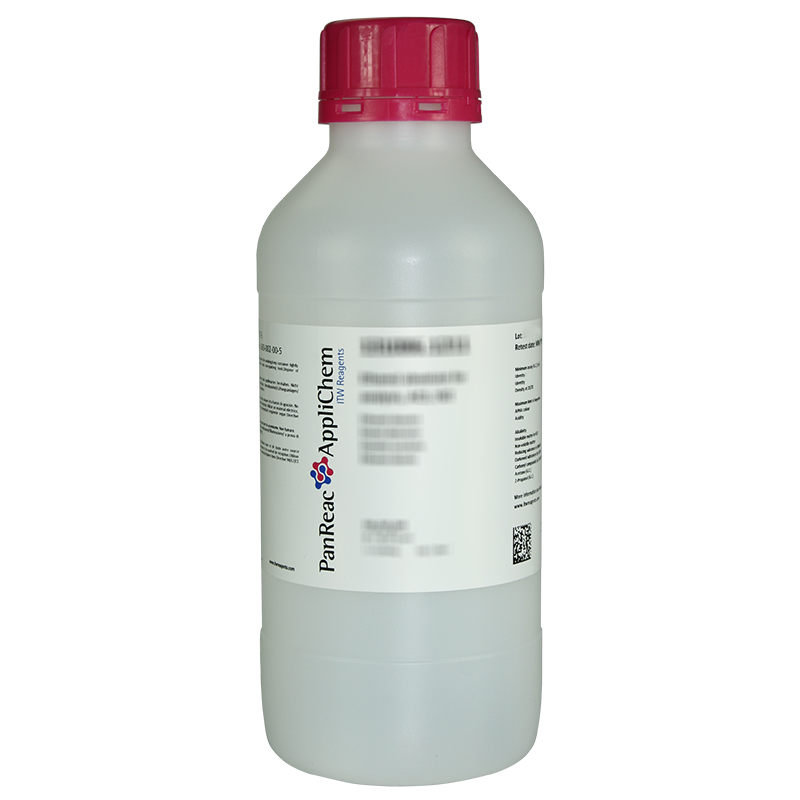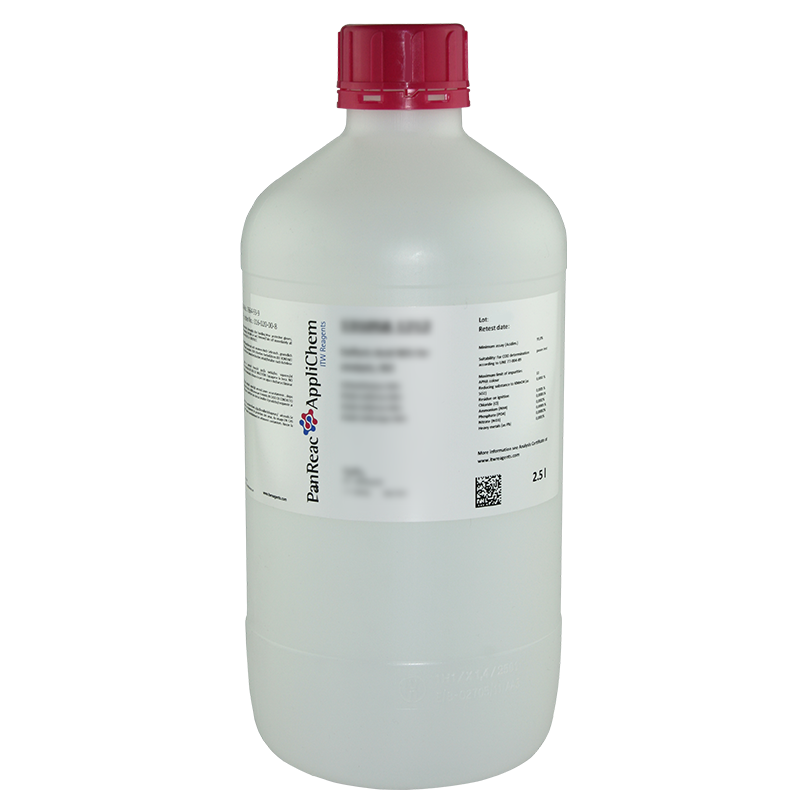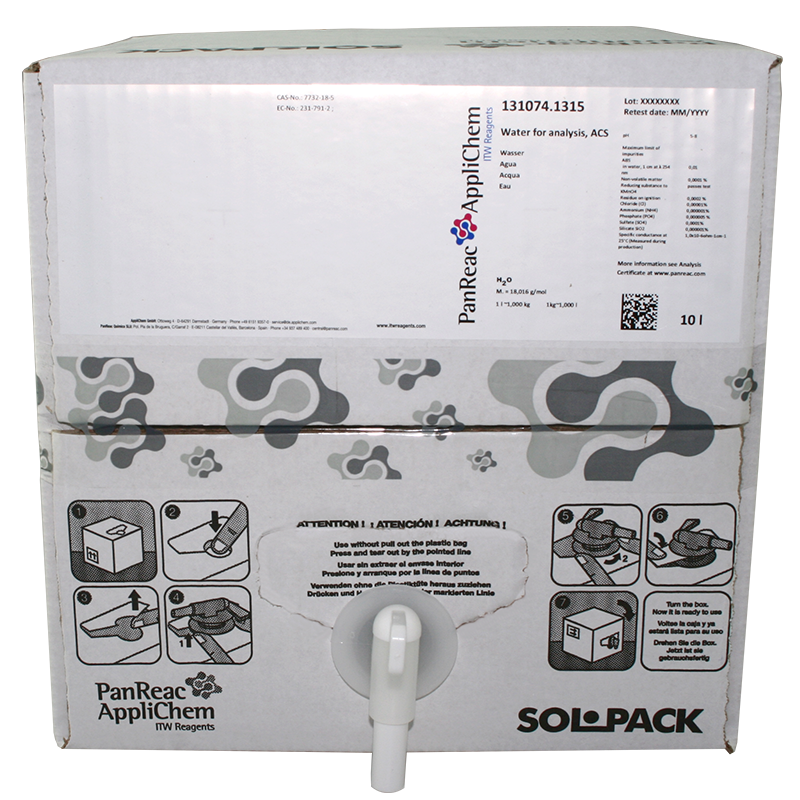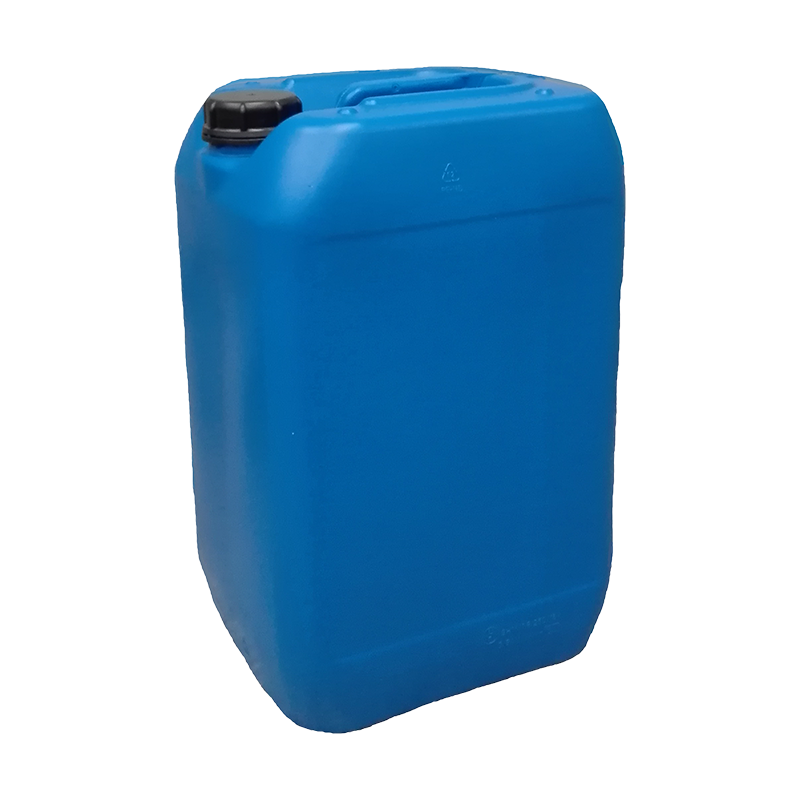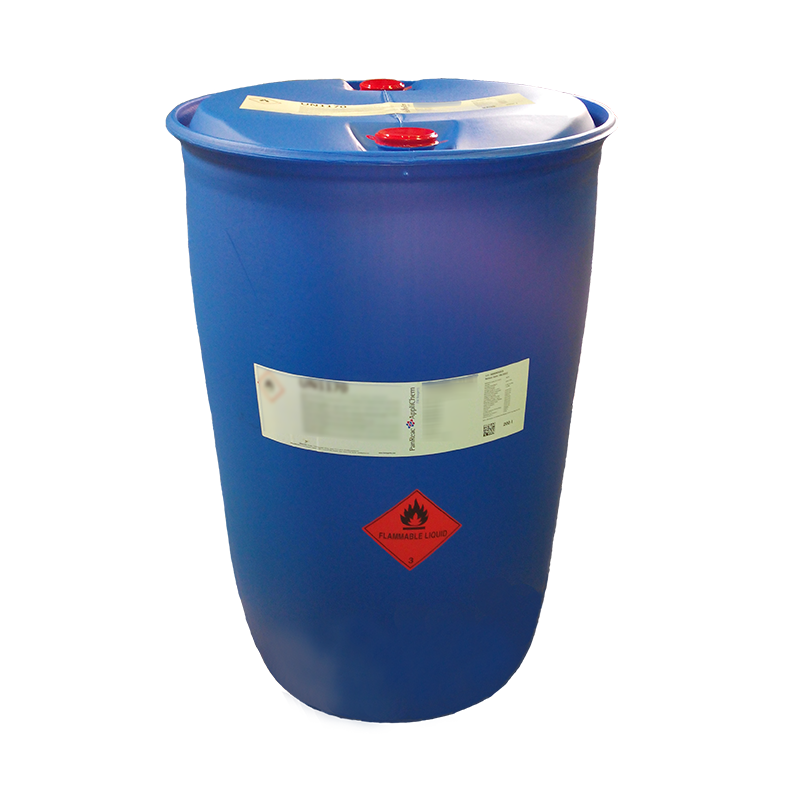Packs sizes (6)
| code | packaging size | price per unit | box price per unit | |
|---|---|---|---|---|
| Code & packaging | Price per piece | |||

|
code
131074.1211
|
packaging size
1000 ml
|
price per unit
single
14,50€
|
box price per unit
12,33€x 6 units
|

|
code
131074.1212
|
packaging size
2.5 l
|
price per unit
single
32,30€
|
box price per unit
27,46€x 4 units
|

|
code
131074.1214
|
packaging size
5 l
|
price per unit
single
37,60€
|
box price per unit
31,96€x 4 units
|

|
code
131074.1315
|
packaging size
10 l
|
price per unit
single
77,00€
|
box price per unit
|

|
code
131074.0716
|
packaging size
25 l
|
price per unit
single
119,90€
|
box price per unit
|

|
code
131074.0719
|
packaging size
200 l
|
price per unit
single
784,00€
|
box price per unit
|
Technical data
- Melting Point:
- 0 °C
- Boiling Point:
- 100 °C
- Density:
- 1.000 kg/l
- Solubility:
- Soluble in ethanol
- Physical Description:
- liquid
- Product Code:
- 131074
- Product Name:
- Water for analysis, ACS
- Quality Name:
- for analysis, ACS
- Specifications:
- pH: 5-8
Maximum limit of impurities
ABS in water, 1 cm λ 254 nm: 0.01
Non-volatile matter: 0.0001 %
Reducing substance to KMnO4: passes test
Residue on ignition: 0.0002 %
Chloride (Cl): 0.00001%
Ammonium (NH4): 0.000001%
Phosphate (PO4): 0.000005 %
Sulfate (SO4): 0.0001%
Silicate SiO2: 0.000001%
Specific conductance at 25°C (Measured during production): 2.0x10-6ohm-1cm-1
Nitrate (NO3): 0.00002%
Heavy metals (as Pb): 0.000001%
Metals by ICP [in mg/Kg (ppm)]
Ag: 0.01
Al: 0.02
As: 0.05
Au: 0.01
B: 0.01
Ba: 0.01
Be: 0.02
Bi: 0.01
Ca: 0.1
Cd: 0.01
Co: 0.01
Cr: 0.01
Cu: 0.01
Fe: 0.01
Ga: 0.01
Ge: 0.01
Hg: 0.05
In: 0.01
K: 0.05
Li: 0.02
Mg: 0.05
Mn: 0.01
Mo: 0.01
Na: 0.1
Ni: 0.01
Pb: 0.01
Pt: 0.01
Sb: 0.01
Se: 0.01
Sn: 0.01
Sr: 0.05
Ti: 0.01
Tl: 0.01
V: 0.01
Zn: 0.05
Zr: 0.01
Meet specifications for water type 2 according to ISO:3696:1987. 'Water reagent for use in laboratory analysis'.
- WGK:
- nwg
- Storage:
- Room Temperature.
- Master Name:
- Water
- Synonyms Long Text:
- Hydrogen Oxide
- EINECS:
- 231-791-2
- CS:
- 28539010
Documents
Inquiry
FAQs
What is water / H2O?
Water, chemical formula H2O, is an inorganic, polar chemical substance. Pure water is a clear, tasteless, odorless, and almost colorless liquid (apart from an inherent blue tinge, not noticeable in small quantities). Its chemical formula, H2O, indicates that each of its molecules contains one oxygen atom and two hydrogen atoms, joined by covalent bonds.
The name "water" is also the name of the liquid state of H2O (between 0 °C and 100 °C) at standard temperature and pressure. Water is one of the few substances on Earth that exists naturally in all three states of matter, or states of aggregation, solid (ice), liquid ("water") and gaseous (water vapor). It is the main constituent of the Earth's hydrosphere and of the fluids of all known living organisms. Water is necessary for the subsistence of all forms of life, despite the fact that it does not provide food, energy or organic micronutrients.
What is water / H2O used for?
Water is widely used in laboratories of all kinds, in industrial processes, for domestic uses, in agriculture, as a source of energy, as a means for navigation and transportation, etc. Apart from its use as a beverage and for hygiene, it is an excellent solvent for a wide variety of both mineral and organic substances. Water, ice and steam are also used for cooling and heating.
Is water / H2O a solvent?
The molecules of any solvent exert their action by interacting with those of the solute, giving rise to a homogeneous mixture (dissolution). Polar solutes will be dissolved by polar solvents, such as water, by establishing electrostatic interactions between the dipoles. The high dipole moment of water and its facility to form "hydrogen bonds" with each other and with other molecules make water an excellent solvent. Water dissolves almost all substances except "hydrophobic" substances (fats and oils). In particular, it is an excellent solvent for polar and ionic solutes, which have a high affinity for water: salts, sugars, acids, alkalis and some gases (such as oxygen or carbon dioxide). This ability to dissolve most substances makes water a universal solvent.
What properties make water a good solvent?
Water is an inorganic, polar and protic solvent. That is, it does not contain carbon (it is inorganic); the molecule has a positive and a negative pole separated by a certain distance, there is a permanent dipole (it is polar); the molecule easily donates protons to solutes (it is protic). It is the most important solvent, essential for living things, and the liquid that dissolves the most substances. Water (H2O) has a simple molecular structure, containing one oxygen atom and two hydrogen atoms. Each hydrogen atom is bonded to the oxygen by a covalent bond. The oxygen atom is very electronegative, i.e. it attracts the shared electrons of the covalent bond much more strongly than the hydrogen, generating an excess of negative charge on the oxygen side and positive charge on the hydrogen side. The asymmetric electron density distribution creates an electric dipole moment, and water molecules can have strong electrostatic interactions with other polar molecules or charged atoms. Water's high dipole moment and its facility to form "hydrogen bonds" with each other and with other molecules make water an excellent solvent. Hydrogen atoms are not only covalently bonded to their oxygen atoms, but are also attracted to other nearby oxygen atoms. A molecule or ion is soluble in water if it can interact with water molecules by hydrogen bonds (also called hydrogen bridge bonds) or ion-dipole interactions. Water owes its superiority as a solvent for ionic substances not only to its polarity and high dielectric constant but also to its solvating power (ability to form strong bonds with dissolved ions).
What is a hydrogen bonding or a hydrogen bridge bonding?
Hydrogen bonding or hydrogen bridge bonding is a special type of strong dipole-dipole interaction. In this type of bond, hydrogen bonded to an electronegative atom (oxygen in the case of water) is highly electropositive. This hydrogen can easily combine with the negative end of a polar molecule or with molecules with a lone pair of electrons. Therefore, hydrogen bonding is formed between molecules of the same substances, between molecules of different substances or between two atoms of the same molecule. The interaction of a solute with a solvent leads to stabilization (dissolution) of the solute species in solution. The high dipole moment of water and its facility to form hydrogen bonds with each other and with other molecules make water an excellent solvent.
What substances cannot dissolve in water?
Substances that tend to interact or dissolve with water are classified as hydrophilic. A hydrophilic substance is polar and usually contains O-H or N-H groups that can form hydrogen bonds with water. For example, glucose, with its five O-H groups, is hydrophilic. Conversely, a hydrophobic substance, i.e. one that repels water, tends to be nonpolar and therefore prefers other neutral molecules and nonpolar solvents. Since water molecules are polar, hydrophobes do not dissolve well in water. Examples of hydrophobic molecules are alkanes, oils, fats and fatty substances in general. The term hydrophobic is often used interchangeably with lipophilic, a substance that has an affinity for lipids or fats. However, the two terms are not synonymous. Although hydrophobic substances are usually lipophilic, there are exceptions, such as silicones and fluorocarbons. Most sulfides, oxides, carbonates, chromates, phosphates and hydroxides of metals are not soluble in water, since their molecules do not readily bind to those of water. Salts of silver, mercury and lead with chlorides, iodides and bromides are also not soluble, although there may be some exceptions. Some of the sulfate salts, such as barium sulfate, strontium sulfate and lead sulfate, are not soluble in water. In addition, calcium sulfate, silver sulfate, and mercury sulfate are only slightly soluble in water.
Does water have a CAS number?
Yes. Like any other chemical, water has a CAS number assigned to it. It is 7732-18-5.
What is the molar mass of water?
The molar mass of water is 18.0153 grams per mole.
What is the melting point of water?
The melting point of water is the temperature at which it changes from solid ice to liquid water. The solid and liquid phase of water are in equilibrium at this temperature. The melting point is slightly pressure dependent, so there is no single temperature that can be considered the melting point of water. However, for practical purposes, the melting point of pure water ice at 1 atmosphere of pressure is very close to 0 °C, which is 32 °F or 273.15 K. The melting point and freezing point of water are ideally equal, especially if there are gas bubbles in the water, but if the water has no nucleation points, the water can supercool to -42 °C (-43.6 °F, 231 K) before freezing. So, in some cases, the melting point of water is considerably higher than its freezing point.
What is the boiling point of water?
The boiling point of water is 100 °C or 212 °F at 1 atmosphere of pressure (sea level). However, this value is not a constant. The boiling point of water depends on atmospheric pressure, which changes with altitude. Water boils at a lower temperature as altitude is gained (e.g., climbing a mountain), and boils at a higher temperature if atmospheric pressure is increased (at sea level or below). The boiling point of water also depends on its purity. Water containing impurities (such as salt water) boils at a higher temperature than pure water. This phenomenon is called boiling point elevation, which is one of the colligative properties of matter.
What is the density of water?
The maximum density of water is 1.00000 grams per cubic centimeter (g/cm3 ) at 3.98 °C. The density at 25 °C is 0.99705 g/cm3.
What is the dipole moment of water?
The dipole moment of water is 1.85 D.
What is the dielectric constant of water?
The dielectric constant or relative permittivity of water is 78.5.
What is the dissociation constant of water?
Due to the high polarity of water molecules, hydrogen bridges are formed between them and as a consequence, a water molecule has the capacity to yield a proton to a neighboring molecule and this causes the molecule that yielded its proton to have a net negative charge and the water molecule that accepts it to have a positive charge. This indicates that water is ionized, since it acts as an acid by donating protons (H+), also called hydrogen ions, and as a base by accepting them, according to the theory of Brønsted and Lowry. Thus, water can be found in two ionic species: hydronium (H3O+), a water molecule that accepts a proton and functions as an acid, and hydroxyl OH-, which is the species that remains when the water molecule gives up its proton, and which functions as a base, since it can accept protons. The hydronium ion (H3O+ ) is simplified as H+ (hydrogen ion or proton). The dissociation of water is an equilibrium reaction. It means the rate of the forward reaction is equal to the rate of the reverse reaction and the concentration of the reactants and products do not change at equilibrium. When pure liquid water is in equilibrium with hydrogen and hydroxide ions at 25 °C, the molar concentration of OH- represented as [OH-] is equal to the molar concentration of H3O+ in pure water, i.e., [H3O+] = [OH-] = 10-7 M, where M is in moles/liter or which is the same, [H+] = [OH-] = 1.0 × 10-7 mol/L. The dissociation constant of water is denoted Kw = [H+] [OH-] = 1.0 - 10-14. Any solution in which the concentrations of H+ and OH- are equal is considered a neutral solution (pH = 7). Completely pure water is neutral, although even small amounts of impurities can affect these ion concentrations and the water would no longer be neutral. Kw is sensitive to pressure and temperature, increasing as either increases.
What is water used for in a laboratory?
The water used in laboratories, misnamed "distilled" water, is actually "purified" water in which, to a greater or lesser degree, various impurities, both organic and inorganic, have been removed. Water is the most important reagent in the laboratory and is present in most of the processes and solutions used in the laboratory. The purity and quality of water used for analytical purposes has a great impact on the reliability and accuracy of analytical results. To obtain water with the desired quality, different methods are used such as distillation, ultrafiltration, reverse osmosis, deionization, etc., as well as combinations between the techniques, with the aim of transforming common water into a reagent for the laboratory. Having water of the right quality in laboratories requires advanced purification technology and strict control of impurities and parameters that can affect each determination. Highly sensitive analyses depend to a large extent on high water purity. Different standardizing bodies such as ISO (International Organization for Standardization), ACS (American Chemical Society), ASTM (American Society for Testing and Materials), Standard Methods for Analysis of Water and Wastewaters etc., define specifications for water used in analytical laboratories, for example in ISO 3696 (water for use in laboratory analysis) or ASTM D1193 (standard specification for water as a reagent). Similarly, pharmacopoeias, such as the European Pharmacopoeia (EP or Ph. Eur.) and USP (United States Pharmacopoeia), also establish purity criteria for different types of water for pharmaceutical use.
What are the applications of water in a laboratory?
Water is the most important reagent in the laboratory and is present in most of the processes and solutions used in any laboratory. Due to its multiple applications, it is of vital importance to choose water of the appropriate quality grade to obtain high quality, reliable and accurate results. There are different grades of water purity and quality depending on the type of analysis, the technique used or the application. Some of its applications range from material and equipment washing, sample preparation, dilutions, standards, volumetric solutions, buffer solutions, culture media, eluents, reagent preparation in general, to the use of highly sensitive techniques such as ICP-MS (inductively coupled plasma source mass spectrometry), ICP-OES (inductively coupled plasma optical emission spectrometry), atomic absorption spectrometry (AAS), UV/VIS spectrophotometry, chromatographic techniques such as HPLC (high performance liquid chromatography), UHPLC (ultra high performance liquid chromatography), LC-MS (liquid chromatography/mass spectrometry), GC-MS (gas chromatography/mass spectrometry). Chromatography is currently the main method used for the separation of mixtures of closely related chemical species. It can be used for qualitative identification and quantitative determination of the separated species. The different chromatographic techniques have a relevant role, among others, in the conservation of the environment for the analysis and control of contaminants in drinking water, wastewater, soil, sewage sludge, air samples, etc. Some of these contaminants are polyaromatic hydrocarbons (PAH), volatile organic compounds (VOC), persistent organic pollutants (POP), polychlorinated biphenyls (PCB), dioxins, furans, pesticides in general (insecticides, herbicides, fungicides, etc.), organochlorine and organophosphorus pesticides, nitrites, amines, phenols, etc. It is also used for applications in molecular biology, electrochemistry, electrophoresis, tissue culture, etc.
What are the different degrees of purity and quality of water used as a laboratory reagent?
Choosing the appropriate water quality grade is of vital importance in any laboratory in order to obtain high quality, reliable and accurate analytical results. There are different specific water purity and quality grades depending on the type of analysis, technique used or application; for example:
- For genomics and molecular biology laboratories, for PCR analysis --> Water, for PCR, DNA free, for molecular biology, suitable for qPCR.
- For biochemical research laboratories, e.g., in preparation of antibiotic solutions --> Double distilled water, sterile.
- For general analytical applications requiring high levels of purity and very low impurity content --> water for analysis, ACS (meets American Chemical Society specifications).
- For material washing, steam generators --> Technical grade water.
- For oral drug production, equipment cleaning or cosmetics production --> Purified water (BP, Ph. Eur.) pure, pharma grade.
- For instrumental analytical techniques:
Supergradient UHPLC water --> Suitable for use in UHPLC equipment. This technique provides faster analysis than HPLC, better sensitivity and higher resolution. Solvents with high transparency at low wavelengths and maximum baseline stability are required. When working at higher pressures, the fixed solvent residue must be minimized to prevent the equipment pump from blocking.
Water for UV, HPLC, ACS --> For use as a multi-purpose solvent for HPLC and UV-Vis/IR spectroscopy. HPLC is a method used in almost all areas of chemistry, biochemistry and pharma. For example: in pharmaceutical product development HPLC analysis is used to check product purity at different stages of the process; for analysis of environmental pollutants; for determination of drugs or pharmaceuticals in biological samples, for quality control of industrial and fine chemical products, etc.
Water for trace metal analysis (ppt) --> Specially purified by multiple distillation, it is suitable for trace metal analysis by ICP-MS. This technique is used when a very low detection limit of approximately 0.001 μg/L (1 ppt) to 0.01 μg/L (10 ppt) is required. It is used for environmental quality control, pharmaceutical laboratories, reagent manufacturing, research laboratories, reference laboratories for heavy metals in food and feed, mineral studies, etc.
Water for LC-MS --> Characterized by very low metal concentration (<100 ppb) and low particle content due to microfiltration (with 0.2 μm pore filter). The LC-MS suitability is controlled so that no signal is greater than the molecular peak of reserpine (609 amu) at the concentration of 50 ppb, over a range of 200 to 2000 amu. It has a high UV transmittance and an excellent baseline during the HPLC gradient test. The LC-MS (liquid chromatography-mass spectrometry) technique uses liquid chromatography as the separation system and mass spectrometry as the detection system and thus combines the characteristics of high separation in liquid chromatography and high sensitivity in mass spectrometry. Its high sensitivity and selectivity make it ideal for the identification and quantification of a multitude of compounds in the most complex matrices. The LC-MS technique is being used by an increasing number of research and analysis laboratories in different areas of industry (environmental, pharmaceutical, biotechnological, food analysis laboratories, etc.). It allows the detection of nanogram quantities of a variety of analytes, e.g. drug metabolites in biological fluids, pesticides, food and dietary supplement adulterants, natural product extracts, etc. It is also used for analysis of small and large protein molecules in various matrices, quantification of genotoxic impurities in active pharmaceutical ingredients, for detection of doping agents (such as anabolic agents), for quantification of nucleotides and their derivatives in bacterial cells, proteome quantification, in rapid assays for the detection of SARS-CoV-2, etc., for quantitative analysis of molecules at very low concentrations (metabolic pathways, hormones, metabolism, synthetic impurities, etc.).



